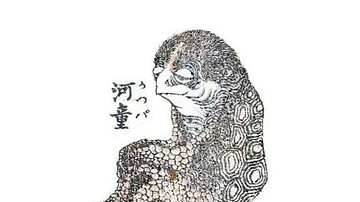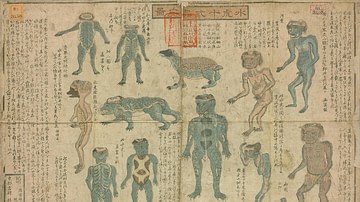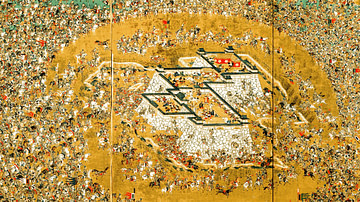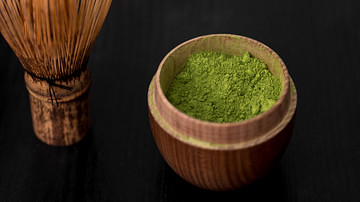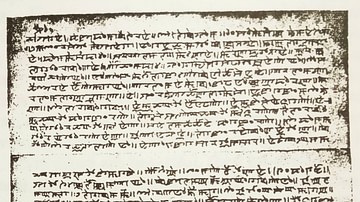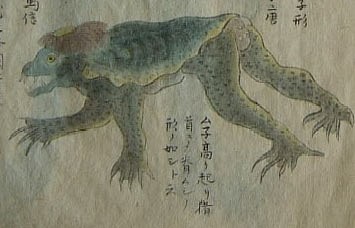
A kappa is a Japanese mythological water sprite or, literally, "river child" (河童). One of the more popularly known yōkai (Japanese mythological creature) in Japan, kappa are generally green or yellow, have a tortoise-like shell on their backs, a tonsured head, and a fishy smell. Their behaviour ranges from helpful and mischievous to downright malevolent, as they are known to stalk the water's edge and drag unfortunate passers-by into the depths.
Origins
A kappa is sometimes called a kawatarō ("river boy") or kawatora ("river tiger"). Another name is suiko ("water tiger"), an adaptation of shuihu, a Chinese mythological creature that is starkly similar to the kappa, and often used interchangeably.
It is assumed that the earliest account of kappa is in Japan's second-oldest book of classical history, Nihon Shoki. In Volume 8, Emperor Keiko orders the removal of malevolent creatures from a river, with one of them being called a "water spirit". Other origins of the kappa might be Chinese or Ainu folklore, the latter example being the mintuci, a water sprite of similar description to kappa, although some tales of the mintuci may have been influenced by those of the kappa.
It was during the Edo Period (1603-1867) however, that kappa became more widely known, with them appearing in kabuki theatre plays, ukiyo-e woodblock prints, and paintings. In the early 1900s, Kunio Yanagita (1875-1962) released one of Japan's most popular and influential books on local folklore, Tono Monogatari (1910), in which the kappa features.
Appearance & Behaviour
Kappa are described as green and yellow in colour, with a tortoise-like shell on their backs, and a beak for a mouth, similar to that of a tengu (a yōkai with a bird-like appearance). They also prominently feature a tonsured head, wherein the top of their head is bald, shaped like a sara (dish) and filled with water. This being a sensitive part of their bodies, kappa are sometimes shown with a cap to cover their head. Their skin is scaled or slimy, and they smell of fish.
They are described as being adept in water and clumsy on land, however, this does not stop them from venturing from the water's edge. While they are described as being mischievous and prankish to humans by hiding objects, scaring away fish, and generally trying to disrupt daily activities, some tales tell of a darker side of their nature. They might lure humans to the water with cries of help or laughter, only to grab and drown their victims. After this, the kappa might drink the human's blood and eat their liver or shirikodama, a mythological organ that supposedly harbours the soul. The kappa were also known for drowning horses or other domestic animals, after which they would drink the animal's blood through its anus.
There are tales of kappa challenging humans to a game of shogi or sumo wrestling. In the case of the latter, because of the kappa's overwhelming strength, it is advised that one should strike the head of the kappa, spilling the water from its sara and rendering it helpless. Another writer suggests shaking your head during the wrestle, which the kappa will imitate, emptying its sara. In the same vein, upon encountering a kappa, if one bows, the kappa, being obsessed with politeness, will do the same, upturning its sara.
Once its sara is emptied, the kappa remains motionless until it is filled again. If a human happens to do this, the kappa will supposedly forever serve them. Similarly, if a human pulls a kappa's arm from its body, which is a weakness of the creature, it will serve the human in exchange for its return. As they are highly intelligent and knowledgeable, they might teach humans spells or recipes, such as that of a family in Himeji, who sold a medicine for broken bones known as the "kappa's remedy", which a kappa taught to an ancestor of theirs.

Kappa are well-known for their love of, amongst other things, cucumber. While some believed that eating cucumber before swimming would ward off kappa, others believed that it would ensure an attack. Still others believed that simply throwing a cucumber into the water would appease the creatures. On the other hand, gourds, melons, fireworks, and iron are frightening to kappa, with iron being a particular fear for many yōkai.
Kappa by Ryūnosuke Akutagawa
The famous short-story author Ryūnosuke Akutagawa (1892-1927) framed a critical analysis of the social and political mores of early 20th-century Japan in the form of a dystopian novel titled Kappa, published in 1927 – the same year in which Akutagawa committed suicide. In it, a human, named only 'Patient No. 23', accidentally finds themselves in the world of these creatures, and the reader is given a tour of this unknown land.
Akutagawa's kappa are somewhat civilised compared to the usual folklore kappa, and a few interesting characteristics are revealed: for example, they are given a choice as to whether they wish to be born or not, with Patient No. 23 listening to an unborn kappa say,
I don't want to be born. First of all, my father's heredity alone is terrible, with mental illness. Moreover, I believe kappa existence to be evil.
(quoted in Akutagawa, 17)
While this and other examples of kappa behaviour that Akutagawa notes are not part of the "official" lore, it is interesting to note the creature's continued relevance in modern literature as well as the versatility of folklore in exploring contemporary issues. Indeed, Akutagawa's kappa find themselves politically divided between capitalist and communist thought, a popular topic after the overthrow of the Russian Tsar in 1917.
Cultural Significance
Kappa have had an indelible mark on Japanese culture, ranging from the folklore tales of the Edo Period to modern-day mascots, designed to sell merchandise. A notable example is when Portuguese Jesuit priests first introduced Christianity in Japan in 1549, their tonsured heads were compared to those of the kappa, showing a general level of mistrust for the foreigners.
Folklore tales often attempt to impart moral lessons, and the kappa is no different: rendering a kappa helpless by bowing to it is an example of the importance of good manners, and the kappa being a water yōkai warns about the potential dangers of swimming.
In food, kappamaki is a kind of sushi roll that prominently includes cucumber. It is generally agreed that the "kappa" in kappamaki refers to the water sprite and its love for the fruit. Kappa also feature on modern-day warning signs, warding children away from swimming in dangerous areas.

In media, kappa are found in anime, manga, books, TV shows, and movies, with there being a number of films being dedicated to the creature, including Death Kappa, a movie about a destructive kappa akin to Godzilla, and in Teenage Mutant Ninja Turtle, where the brothers travel through time to ancient Japan and are mistaken for kappa.
The city of Kōchi has a mascot called Kappa no Kō-chan, a cute, cuddly, and friendly version of the kappa that is used to promote the area during events. There are many Kappa Matsuri (Kappa Festivals) that happen around Japan as well, where participants might dress up as kappa and engage in water sports, sumo wrestling, and generally acting as a kappa would.
Japan's largest freshwater lake, Lake Biwa, is said to be the home of many kappa and also hosts a floating pavilion, at different times of the year, called KAPPA, after the yōkai's namesake. Being multifunctional, the pavilion can be converted into a theatre, restaurant, cinema, or simply a shaded swimming area.
Tono City & Kappa
Tono City, Iwate, is one of the areas with the highest sightings of kappa, and the most associated with yōkai in general, not least because the famous Tono Monogatari reflects upon mythological creatures from the area. One such area with a purportedly large amount of kappa living in it is Kappabuchi, a grove with a stream running through it that stands behind Jokenji Temple in Tono City. People are attracted to the area by the chance of seeing the creatures, and a "master kappa fisherman" even frequents the site to seek out the creature with a fishing pole and cucumber as bait.

Aside from Kappabuchi, kappa are said to swim in many other lakes and rivers in and around Tono City, with Taro Pool being a favourite. The pool was named as such because of a kappa named Taro who supposedly lived there and would sneak up on and cause mischief to the women who would come down to the water's edge to do their washing. A small pool nearby Taro's was said to have been the home of Onna-ga-fuchi, a female kappa who was Taro's mate.
In 2022, Tono Furusato Shosha, an organisation that promotes tourism in Tono City, posted thousands of flyers, similar to wanted posters, up around tourist areas that pleaded for anyone to come forward with information on sightings of kappa in an attempt to promote the area and draw crowds. Similarly, Tono TV, a local broadcast station, put out a bounty of 10 million yen for the capture of a kappa. In order for the capture to be 'legal' however, the lucky individual would first need to acquire a "kappa capture permit" from the gift shop near Kappa Falls.


